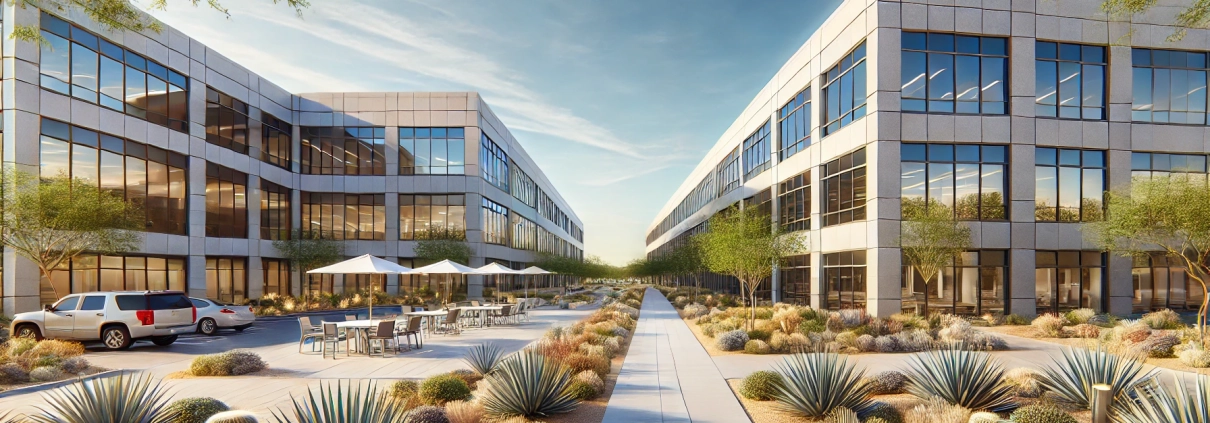Rentable Area
Rentable area is the area within a building to which a landlord can charge rent. This includes the tenants’ private and/or exclusive use space, as well as the building’s common areas.
Tenants usually pay rent for their exclusive space plus a share of the common area. A tenant’s rentable area calculation is commonly calculated by multiplying their usable space by the building’s load factor.
Usable Area + Common Area = Rentable Area
Putting “Rentable Area” in Context
Horizon Equity Partners, a real estate private equity firm, recently acquired Desert Ridge Office Park, a suburban office property located in Phoenix, Arizona. The property consists of two Class A office buildings totaling 100,000 square feet of rentable area. Desert Ridge Office Park features modern amenities, including a shared lobby, conference rooms, and a fitness center, all considered part of the common areas.
Rentable Area Breakdown
One of the major tenants at Desert Ridge Office Park is a regional tech firm occupying 20,000 square feet of usable space. In addition to this exclusive space, the tenant shares responsibility for common areas such as hallways, elevators, and restrooms.
The property manager calculates the building’s load factor at 1.15. This load factor means that for every square foot of usable area, tenants are charged an additional 15% to account for their proportional share of the building’s common areas.
The calculation of the tenant’s rentable area is as follows:
- Usable Area: 20,000 SF
- Load Factor: 1.15
- Rentable Area Formula: Usable Area × Load Factor
- Rentable Area: 20,000 SF × 1.15 = 23,000 SF
Thus, the tenant pays rent based on 23,000 square feet, covering both its exclusive use space and a share of the common areas.
Importance of Rentable Area
Understanding the distinction between usable and rentable area is crucial for both landlords and tenants. From a landlord’s perspective, the rentable area is the basis for revenue generation and lease structuring. For tenants, clarity on the rentable area ensures they understand the total cost implications of leasing space, including shared amenities.
In this hypothetical scenario, Horizon Equity Partners ensures the load factor is competitive with comparable properties in the Phoenix market to attract and retain tenants, while maximizing the property’s revenue potential.
Frequently Asked Questions about Rentable Area in Commercial Real Estate
What is Rentable Area?
Rentable area is the total area for which a landlord can charge rent, including both a tenant’s exclusive usable area and their share of common areas like lobbies, restrooms, and hallways.
How is Rentable Area calculated?
Rentable Area = Usable Area × Load Factor.
For example, a tenant with 20,000 SF of usable area and a 1.15 load factor would have a rentable area of 23,000 SF.
What is a Load Factor?
The load factor represents the ratio of shared/common space to usable space. It determines how much of the building’s common areas are proportionally allocated to each tenant’s rentable area.
Why does Rentable Area matter to tenants?
Tenants pay rent based on rentable area, not just their private space. Understanding this metric helps them assess the total leasing cost and value of shared amenities.
How does Rentable Area impact leasing revenue for landlords?
Rentable area is the basis for calculating rent, so increasing it (via a higher load factor or efficient use of common areas) directly increases leasing revenue for landlords.
What was the Rentable Area of the tenant in Desert Ridge Office Park?
The tenant had 20,000 SF of usable area. With a 1.15 load factor, their rentable area was calculated as:
20,000 SF × 1.15 = 23,000 SF.
How does Horizon Equity Partners use Rentable Area to stay competitive?
They ensure the load factor remains competitive with other properties in the Phoenix market, balancing revenue potential with tenant cost sensitivity to attract and retain tenants.
Click here to get this CRE Glossary in an eBook (PDF) format.

